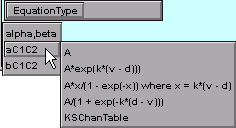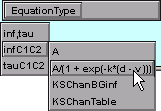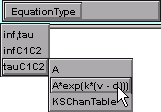
First make sure that the Properties radio button is ON.
The C1-C2 transition
Click on the C1-C2 transition and notice what happens to the GateGUI.
The panel to the right of the canvas contains controls for specifying the "Power" for O and the "fractional conductances" of the closed states C1 and C2. For this mechanism, these parameters should be 1, 0, and 0, respectively.
"Power" is useful for mechanisms in which the conductance depends on cooperative interactions among "open" states."Fractional conductance" is useful for kinetic scheme mechanisms that have more than one conductive state. The total conductance is proportional to the weighted sum of all conductive states.
- Example: if conductance requires interactions between pairs of O states, the Power should be 2 and the total conductance will be
- g = gmax * O^2
- Example: if the single channel conductance associated the C1 and C2 states were 0.1 and 1.5 times that of the O state, we would set the "C1 fraction" to 0.1 and the "C2 fraction" to 1.5. The total conductance would then be
- g = gmax * (O + 0.1*C1 + 1.5*C2)
Now we need to specify the voltage dependence of the C1 - C2 transition. By default the EquationType uses the alpha,beta style. We already have the equations for a1 and b1
a1 = K1/(tau1*(K1+1))
b1 = 1/(tau1*(K1+1))
so this looks like a piece of cake. Just substitute
tau1 = ta1*exp(tk1*vr)
K1 = exp((k2*(d2 - vr)) - (k1*(d1 - vr)))
and rearrange, and we get
a1 = ta1*exp(-tk1*vr)/(1 + exp(k1*(d1-vr) - k2*(d2-vr))
So we look in the menu of alpha,beta functional forms
and find nothing. The expression for a1 just doesn't simplify to anything in this list. We're cooked.
Or are we?
Recalling that
tau = 1/(a+b) and inf = a*tau
we realize that the tau,inf formulation yields functional
forms that are amenable to the Channel Builder.
For tau we get
tau = 1/(a+b) = tau1*(K1+1) / (1+K1) = tau1 = ta1*exp(tk1*vr)
= ta1*exp(tk1*(v+65))
= 4.4*exp(-0.025*(v+65))
which is the exponential functional form with A = 4.4, k = -0.025, and d = -65.
Turning to inf,
inf = a*tau = a1*tau1 = K1/(K1+1)
1/inf = 1 + exp(-k2*(d2 - vr) + k1*(d1 - vr))
Focussing on the exponent,
-k2*(d2 - vr) + k1*(d1 - vr) = k1*d1 - k2*d2 - (k1-k2)*vr
= (k1-k2)*( ((k1*d1 - k2*d2)/(k1-k2)) - 65 - v )
= 0.164*( (4.2 - 1.548)/0.164 - 65 - v )
= 0.164*(2.652/0.164 - 65 - v)
= 0.164*(16.2 - 65 - v) = 0.164*(-48.8 - v)
so
inf = 1/( 1 + exp(0.164*(-48.8 - v)) )
which is the logistic functional form with A = 1, k = -0.164, and d = -48.8
So we select the inf,tau type of equations
Also, we might as well click on "Display inf, tau" so we can see how inf and tau vary with membrane potential.
Finally we select the functional forms for inf and tau, and assign the parameter values.
For inf, click on
EquationType / infC1C2 / A/(1 + exp(k*(d-v)))
The equation displayed for infC1C2 will change, and new buttons and numeric fields will appear for setting the values of A, k, and d. Enter the values of these parameters into the corresponding numeric fields (A = 1, k = -0.164, d = -48.8).
Now for tau. Select the exponential functional form by clicking on
After entering the values for tauC1C2's parameters (A = 4.4, k = -0.025, d = -65), and rescaling the graph in the bottom panel (using View = plot, or better, Set View), the GateGUI tool will look like this
Was there ever a better time to save a session file?
The C2-O transition
Let's deal with the algebra first. For reaction 2 we have
tau = tau2 = ta2*exp(tk2*vr)
= ta2*exp(tk2*(v+65))
= 2.6*exp(-0.007*(v+65))
Like tau for the C1-C2 transition, this is just the exponential form,
but with different parameters (A = 2.6, k = -0.007, d = -65).
What about inf? This time we get a little break --
inf = K2/(K2+1)
= 1/(1 + exp(k2*(d2 - vr)))
= 1/(1 + exp(0.036*(43 - 65 - v)))
= 1/(1 + exp(0.036*(-22 - v)))
which is the logistic form with A = 1, k = -0.036 and d = -22
So
Just out of curiousity, you might want to examine the voltage dependence of a and b for the C1-C2 and C2-O transitions. But don't expect them to look like the hh rate constants.
Before moving on, save the Channel Builder to a session file!
The next step is to test our new channel in a model cell.
Copyright © 2004-2005 by N.T. Carnevale and M.L. Hines, All Rights Reserved.